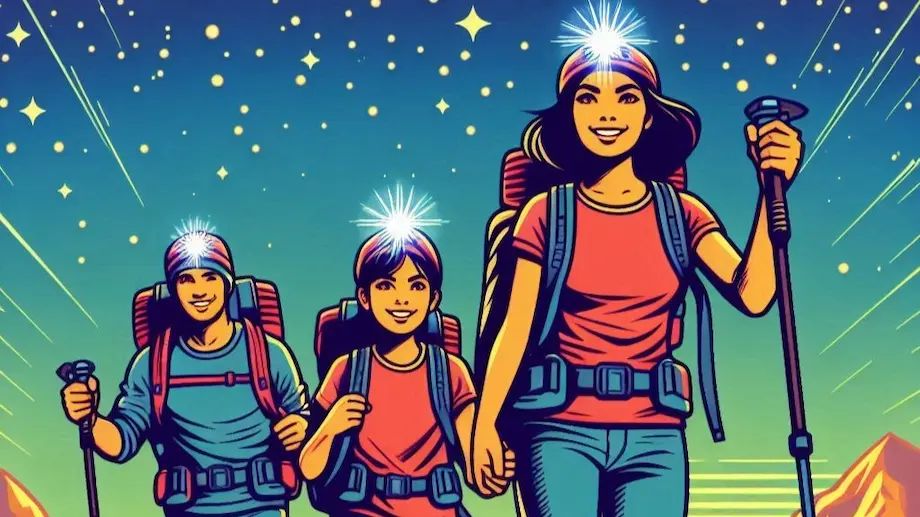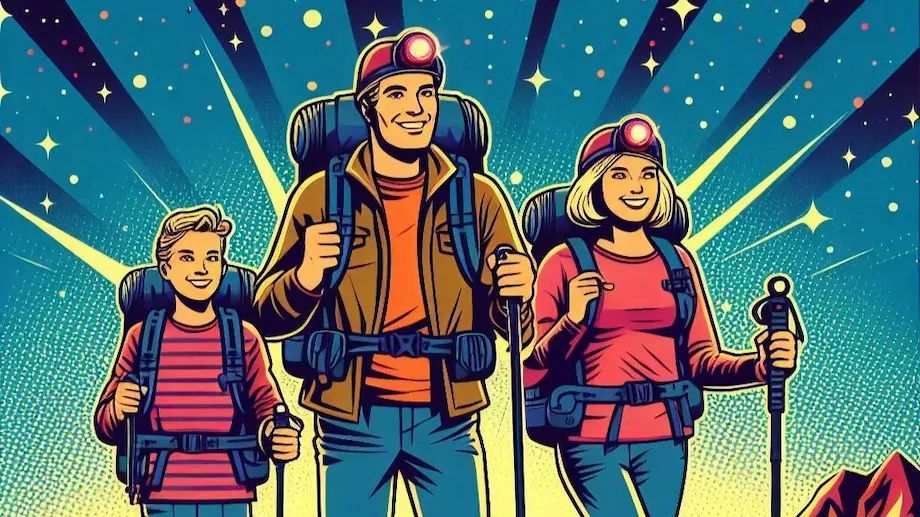Night Hiking 101 How to Stay Safe and Love the Dark
- Last Updated:
The trail doesn’t close when the sun goes down—it just transforms. If you’ve ever stepped into the woods after sunset, you know the world feels quieter, cooler, and strangely more alive. Whether you’re looking to beat the summer heat, avoid crowds, or simply try something new, night hiking opens up a whole new way to explore.
In this guide, we’ll walk you through everything we’ve learned over the years—from essential gear and planning tips to safety tricks and ways to actually enjoy the experience (instead of just surviving it). Let’s make sure your first (or next) night hike is magical, memorable, and safe.

Why Hike at Night? Why a nighttime adventure might be the perfect way to explore.
Night hiking isn’t just a workaround for busy schedules or summer heat—it’s a completely different way to experience nature. With the sun gone, the forest feels mysterious and new. Sounds are sharper, stars are brighter, and even well-known trails can feel like new adventures.
Theres a lot of practical reasons to hike after dark, too. From escaping sweltering daytime temps to avoiding crowds on popular trails, heading out under the moonlight offers both peace and practicality.
- Cooler temperatures: Summer days can be brutal, but the evening breeze is perfect for a more comfortable trek.
- Less crowded: Most folks head home by dinner—giving you peaceful trails and more wildlife sightings.
- Senses awaken: With limited vision, your hearing, smell, and spatial awareness all kick into high gear. It’s a whole different kind of connection to nature.
- And yes the stars, the moonlight, the silence. It’s hard to describe until you’ve felt it for yourself.
What Are the Risks? Be aware of the unique challenges that come with hiking after dark.
Hiking at night can be deeply rewarding—but it also comes with a unique set of challenges. With lower visibility and cooler temps, you’re relying more on your preparation and your instincts. Planning ahead makes all the difference.
Understanding the risks ahead of time helps you stay calm and confident when the sun dips below the horizon.
- Limited visibility: Even with a headlamp, depth perception and trail markers are harder to spot.
- Getting lost: Familiar trails look different in the dark.
- Trip hazards: Rocks, roots, uneven ground—take your time.
- Wildlife: Some critters are more active at night (like raccoons, owls, even bears in some regions).
- Temperature swings: Nights can cool off fast, even in summer.
Night Hiking Checklist Smart packing makes the difference between a safe trek and a stressful one. [Download Printable Checklist]
Being properly equipped is key to enjoying your night hike. Your gear helps you stay oriented, comfortable, and ready for the unexpected. A good setup means you’re not just surviving the experience—you’re actually enjoying it.

BLACK DIAMOND Spot 400 LED Headlamp Waterproof and Dimmable Battery Powered Headlamp for Camping, Hiking, Running, Work, Travel with Red Light Headlamp Mode
- [ ] Backup flashlight + extra batteries - Never rely on one light source.
- [ ] Bug spray or insect repellent.
- [ ] Emergency blanket or lightweight emergency tent.
- [ ] First aid kit - See our guide to hiking first aid kits.
- [ ] Fully charged phone + battery pack.
- [ ] Headlamp (with red-light mode) - A must-have. Check out our headlamp buyers guide.
- [ ] Hiking Pants - Not required but highly recommended. See or buyers guide for men and women
- [ ] Map, compass, or GPS app. Our guide on GPS Navigation Tools for Hikers
- [ ] Personal locator beacon (PLB) or GPS communicator.
- [ ] Small multitool or knife - Will come in useful more often than you would expect.
- [ ] Trekking poles - Great for balance in low light. Here’s how to pick the right pair for you.
- [ ] Water and snacks - Always pack more than you think you’ll need.
- [ ] Weather-appropriate layers - Think moisture-wicking base, insulating mid-layer, and weather-resistant outer shell.
- [ ] Whistle - For notifying people nearby in case of emergencies.
- [ ] Tell someone your plan - Do this for every hike day or night.

Plan Your Night Hike Like a Pro Tips to get your timing, route, and safety plan just right.
The difference between a magical hike and a stressful one often comes down to planning. The more you prepare ahead of time, the less you have to worry about once you’re out on the trail.
If you’re looking for even more practical suggestions, check out our night hiking tips guide—it’s packed with firsthand advice to help you hike smart after dark.
Start when there’s still light in the sky—your eyes may take 30–45 minutes to fully adjust to darkness. Full moon nights also offer a great introduction to night hiking, especially for beginners.
These steps help you build confidence, especially if you’re hiking after dark for the first time.
- Start with a trail you know. This isn’t the time to explore unmarked paths.
- Time it right. Begin your hike 30–60 minutes before sunset so you can adjust gradually.
- Check moon phase & weather. A full moon adds beautiful natural light. Avoid foggy or rainy nights.
- Hike with a buddy. Or a few. There’s safety in numbers.
- Tell someone your plan. Always let a friend know where you’re going and when to expect you back.
- Test your gear. Know how your headlamp works before you’re 3 miles from the car.

Coast GX30 2300 Lumen Waterproof Alkaline and Rechargeable Dual Power LED Flashlight with Twist Focus, Anti-Roll Cap and Textured Handle, 6 x AA Batteries Included (length 8.5 inches)
On the Trail: Tips for a Smooth Night Hike Stay alert and confident with a few simple adjustments.
Once you’re out there, it’s all about staying aware and flexible. The dark can change how you perceive space, sound, and direction—so we recommend easing into your pace and adjusting your senses along the way.
If you’re hiking in a group, assign someone to lead and someone else to take up the rear. This “leader and sweeper” strategy helps make sure no one gets separated, especially when visibility is limited.
Even a short hike can become a memorable experience when you’re moving with intention and calm.
- Keep it slow and steady. Night hiking isn’t a race.
- Use red-light mode when possible. It helps preserve your night vision.
- Stay on trail. Don’t risk shortcuts—especially in the dark.
- Be mindful of noise. You’re sharing the space with nocturnal animals.
- Check in with your group. Pause regularly to make sure everyone’s okay and on pace.
What Night Hiking Feels Like Nature transforms after dark—and so does your connection to it.
There’s a unique rhythm to hiking after dark. Sounds sharpen. Every breeze feels cooler. Your steps seem more deliberate. And when you pause to look up, the stars feel closer than ever.
If you’re in the right spot, night hiking becomes the perfect opportunity to stargaze. Some parks even offer dark-sky trails—places with minimal light pollution where constellations and the Milky Way are brilliantly clear.
Even our dog, Drax, moves differently—more alert, curious, and calm. We often return from a night hike feeling reset. It’s not just a walk in the woods; it’s an experience that stays with you.
Leave No Trace at Night Respecting nature after dark is just as important.
Even under the stars, Leave No Trace principles still apply. Stay on marked trails, keep noise and light pollution to a minimum, and avoid disturbing nocturnal animals. Use red-light headlamps when possible, don’t venture off-trail, and pack out all trash—including snack wrappers and biodegradable waste.
If you’re not familiar with LNT, check out our complete Leave No Trace guide before your next hike.

Leave No Trace Give Nature Some Space Sticker Bumper Sticker Vinyl Decal

Leave No Trace Hiking & Outdoors Sticker
Expert Resources on Night Hiking Trusted advice from leading outdoor organizations.
We’ve shared what works for us, but it’s always smart to cross-reference with expert advice. These resources offer great information on safety, preparation, and technique—perfect for new and seasoned night hikers alike.
- REI: How to Hike at Night – Gear advice, night vision tips, and route planning from REI’s outdoor educators.
- GORE‑TEX: 10 Do’s and Don’ts of Night Hiking – Tips on eye adjustment, lighting, and safety prep.
- National Park Service: Hike Smart – Official safety guidelines for hiking, including after-dark precautions.
- Leave No Trace: 7 Principles – How to minimize your impact on the environment, even during nighttime hikes.
Want to Go Deeper? Challenge yourself with more advanced night hiking skills.
Once you’ve built up some experience, you might be curious to try more advanced night hiking techniques. Some people prefer hiking solo, others experiment with moonlight-only treks. These are amazing—when done safely.
- Solo hiking at night? Only if you’re very experienced. Carry a PLB (Personal Locator Beacon) or a GPS communicator.
- No lights at all? Some hikers try this during a full moon on well-known trails—but ALWAYS carry a light in your pack just in case.
And even at night, it’s important to follow Leave No Trace principles. Stay on trail, minimize light and noise pollution, and be respectful of nocturnal wildlife. Nature doesn’t sleep just because the sun goes down.
Final Thoughts Night hiking can be extraordinary—with the right preparation.
Night hiking can feel intimidating at first—but with a little planning and the right gear, it quickly becomes one of the most rewarding ways to experience the outdoors.
Ready to try it? Let us know where you’re headed, or tag your photos with #AdventureiteNightHike—we’d love to cheer you on.
Stay safe, hike smart, and don’t forget to look up. The stars are waiting.
What to explore next
Your adventure doesn’t have to end here—explore more guides like this one in our Night hiking hub.
If You Found This Helpful, Please Share:
By Summer and Bill

Summer and Bill are the dynamic duo behind Adventureite.com, a blog dedicated to inspiring others to explore the great outdoors. With a combined lifetime of experience traveling and adventuring across America, they have a wealth of knowledge to share. From hiking to camping, kayaking to travel, Summer and Bill are passionate about helping others discover the beauty of the natural world.
 Adventureite
Adventureite